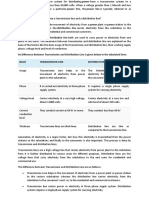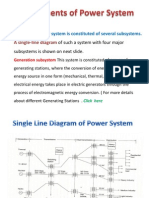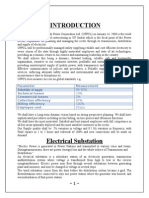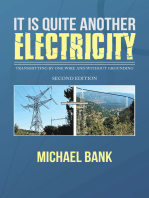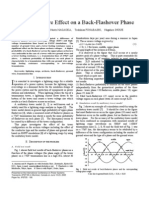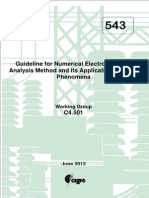T&D Supply System
T&D Supply System
Uploaded by
Anil PalamwarCopyright:
Available Formats
T&D Supply System
T&D Supply System
Uploaded by
Anil PalamwarCopyright
Available Formats
Share this document
Did you find this document useful?
Is this content inappropriate?
Copyright:
Available Formats
T&D Supply System
T&D Supply System
Uploaded by
Anil PalamwarCopyright:
Available Formats
9/18/2014 mydocumentsNTPI_excitationControl 1
E.M.F.-Relation
N
S
EMF, E [volts] = B * l * v.
B = webers / meter Sq.
L = length in Meters
V = Velocity in Meters/Second
current
current
ARMATURE
LOAD
Rotating Armature Generator
Rotating Field Generator
Typical Supply System
The Power System - It Comprises
Generation Units that produce electricity
High Voltage Transmission Lines that transport
electricity over long distances
Low Voltage Transmission Lines That delivers
electricity to Consumers
Substations, which are the part of the electricity
transmission and distribution system where the
voltages are transformed to lower levels for
distributing power to end user.
Component Description
Grid Substation (GSS)
Power from transmission network is
delivered to sub-transmission
network after stepping down the
voltage to 66 kV or 33 kV through
220/132/66/33kV Grid substations.
Sub-transmission Network Power is carried at 66 or 33
kV by overhead lines or underground
cables
Power Sub-Transmission
(PSS)
Power is stepped down by 66-33/11
kV to 11 kV for distribution.
Primary Distribution
Feeders
Power is delivered from PSS through
primary feeders at 11 or 6.6 kV to
various distribution transformers.
Distribution Substation
(DSS)
Power is further stepped down by
11/0.4 kV transformers to utilisation
voltage of 415 V.
Secondary Distribution
Network
It carries power from DSS at 415 V
(240 V single phase) to various
consumers through service lines and
cables.
Major Players
Central Utilities such as NTPC, NHPC,
Nuclear Power Corporation, Damodar
Valley Corporation and NEEPCO.
State Electricity Boards which are state-
owned utilities like Orissa, Haryana, AP,
Uttar Pradesh, Karnataka etc.
Licensees such as BSES and CESC.
Independent Power Projects (IPPs)
Four basic energy sources Electric Power Generation
Fossil fuel such - coal, oil and natural gas
Hydro electricity
Nuclear Power and
Renewable Energy
bio-fuels, solar, biomass, wind and tidal.
Transmission
In India, the power plants typically produce 50
cycle/second (Hertz) alternating current (AC) with
voltages between 11 kV and 25 kV.
Higher voltage means lower current but the
insulation thickness and size increases.
Hence an optimum voltage is selected.
Electric power is brought from the power plant to
the consumer through an extensive transmission
and distribution (T&D) system.
comprising distribution networks, state grids and
regional grid.
Stages of Transmission
At the plant, the 3-phase voltage is generated and
stepped up to a higher voltage for transmission on
conductors strung on cross country towers.
High voltage(HV) and Extra High Voltage (EHV)
transmission in the next stage to transport A.C. power
from the power plant over long distances at voltages
like 220kV, 400kV and 760 kV.
For longer distances and higher powers, higher voltages
are economical.
In special cases HVDC (High voltage direct current
transmission + 500 kV DC) is preferred.
Example 1500 MW Chandrapur Padghe HVDC in
Maharashtra.
Stages of Transmission .
Sub- Transmission network at 132 kV. 110kV,
66 kV or 33 kV constitutes the next link
towards the end user.
Network planning concept >(n-1)
Major Players:
Most of the states restructured their State
Electricity Boards and have unbundled them in
three entities-
Generation, Transmission and Distribution.
Distribution
Distribution at 11KV (6.6 KV in US) constitutes the
last link to the consumers which is connected
directly or through step-down transformers.
11/0.4 KV or 6.6/0.110 KV Transformers.
These transformers bring the voltage levels down
to 400 V / 110 V. for 3 phase, 4 wire secondary
distributions.
The single phase residential lighting load is
connected between any phase and neutral
(230 V/110 V) and 3-phase load is connected
across 3-phase lines directly.
Power Distribution System
Electricity is carried through a transmission network
of high voltage lines.
Usually, these lines run into hundreds of kilometres
and deliver the power into a common power pool
called the grid.
The grid is connected to load centres (cities)
through a sub-transmission network of usually 33
kV (or sometimes 66 kV) lines.
These lines terminate into a 33 kV (or 66 kV)
substation, where the voltage is stepped-down to
11 kV for power distribution to load points through
a distribution network of lines at 11 kV and lower.
The power network concern to the end-user is the
distribution network of 11 kV lines or feeders downstream of
the 33 kV substations.
Each 11 kV feeder which emanates from the 33 kV substation
branches further into several subsidiary 11 kV feeders to
carry power close to the load points (localities, industrial
areas, villages, etc.).
At these load points, a transformer(DTC), further reduces the
voltage from 11 kV to 415 V to provide the last-mile
connection through 415 V feeders (also called LT feeders) to
individual customers, either at 240 V (as single-phase supply)
or at 415 V (as three-phase supply).
The utility voltage of 415 V, 3-phase is used for running the
motors for industry and agricultural pump sets and 240 V,
single phase is used for lighting in houses, schools, hospitals
and for running industries, commercial establishments, etc.
Components of T&D System
Transformers.
Circuit Breakers .
Isolators.
Surge Diverters. (L.A.)
Horn Gaps.
Drop Out Fuses (D.O.)
Current Transformers (C.T.)
Potential transformers (P.T.)
Reactors.
Capacitors.
Cables .
Conductors.
CCGT-UTRAN-SWITCHGEAR
DISTRIBUTION - 18/09/2014 - P
17
Current Transformer.
Measurement of current
is the essence in all
transducers.
The current carrying conductor is threaded
through a donut shaped device.
A C.T. produces an alternating current or
alternating voltage proportional to the
current being measured.
CCGT-UTRAN-SWITCHGEAR
DISTRIBUTION - 18/09/2014 - P
18
3-phase C.T.s
CCGT-UTRAN-SWITCHGEAR
DISTRIBUTION - 18/09/2014 - P
19
LIVE TANK C.T.
PRIMARY
TANK SECONDARIES
BASE
I
N
S
U
L
A
T
O
R
CCGT-UTRAN-SWITCHGEAR
DISTRIBUTION - 18/09/2014 - P
20
DEAD TANK C.T.
SECONDARIES
I
N
S
U
L
A
T
O
R
CCGT-UTRAN-SWITCHGEAR
DISTRIBUTION - 18/09/2014 - P
21
E.H.V.-C.T.
DRYSHIELD
TYPE
CCGT-UTRAN-SWITCHGEAR
DISTRIBUTION - 18/09/2014 - P
22
C.V.T.
E.H.V.BUS / LINE
Capacitors
windings
When a C.T.is to be changed, proper matching is MUST
LIGHTNING ARRESTERS
The earthing screen and ground wires can well
protect the electrical system against direct
lightning strokes but they fail to provide
protection against travelling waves, which may
reach the terminal apparatus.
The lightning arresters or surge diverters provide
protection against such surges.
A lightning arrester or a surge diverter is a
protective device, which conducts the high
voltage surges on the power system to the
ground
EHV LIGHTNING ARRESTER
System Voltage : 0.5 ~ 245kV
Rated Voltage (kV) : 0.5 ~ 216kV
Nominal discharge current (kA) : 5
~ 10 kV
High current capability (4/10us) kA
: 65 ~ 100
Energy Class : D, 1, 2 & 3
Energy absorption Capability kJ/kV
: 2 ~ 8
Short Circuit (Pressure relief) kA :
40
Standard in accordance with : IEC
60099-4 & IS 3070 Part III
Working Principle of L.A.
Surge Arrester consists of highly non-linear varistor
elements housed in a non porous electrical porcelain
housing .
When an electric surge due to
natural lightning or
switching action
appears across the arrester, the block stack allows
the entire energy to earth by posing a very low
resistance and instantaneously recovers to its original
insulation property after the passage of surge,
getting ready for next operation.
Lightening Arrester / Surge Diverter
L.A. Functioning
It consists of a spark gap in series with a non-linear
resistor.
One end of the diverter is connected to the terminal of
the equipment to be protected and the other end is
effectively grounded.
The length of the gap is so set that normal voltage is not
enough to cause an arc,
but a dangerously high voltage will break down the air
insulation and form an arc.
The property of the non-linear resistance is that its
resistance decreases as the voltage (or current) increases
and vice-versa.
This is clear from the volt/amp characteristic of the
resistor shown in Fig.
The action of the lightning arrester or surge diverter
is as under:
(i) Under normal operation, the lightning arrester is
off the line i.e. it conducts no current to earth or the
gap is non-conducting
(ii) On the occurrence of over voltage, the air
insulation across the gap breaks down and an arc is
formed providing a low resistance path for the surge
to the ground.
In this way, the excess charge on the line due to the
surge is harmlessly conducted through the arrester
to the ground instead of being sent over the line.
(iii) It is worthwhile to mention the function of
non-linear resistor in the operation of arrester.
As the gap sparks over due to over voltage, the
arc would be a short-circuit on the power system
and may cause power-follow current in the
arrester.
Since the characteristic of the resistor is to offer
low resistance to high voltage (or current),
it gives the effect of short-circuit.
After the surge is over, the resistor offers high
resistance to make the gap non-conducting.
Horn Gap Protection
Working of Horn Gap Protection
Horn shaped metal rods A and B separated by a small air gap.
The distance between horns gradually increases towards the
top as shown.
The horns are mounted on porcelain insulators.
One end of horn is connected to the line through a resistance
and choke coil L while the other end is effectively grounded.
The resistance R restricts the follow current to a small value.
The choke coil offers small reactance at normal power
frequency but a very high reactance at transient frequency.
Thus the choke does not allow the transients to enter the
apparatus to be protected.
The gap between the horns is so adjusted that normal supply
voltage is not enough to cause an arc across the gap.
Under normal conditions, the gap is non-
conducting i.e. normal supply voltage is
insufficient to initiate the arc between the gap.
On the occurrence of an over voltage, spark-over
takes place across the small gap G.
The heated air around the arc and the magnetic
effect of the arc cause the arc to travel up the
gap.
The arc moves progressively into positions 1,2
and 3.
At some position of the arc (position 3), the
distance may be too great for the voltage to
maintain the arc; consequently, the arc is
extinguished.
The excess charge on the line is thus conducted
through the arrester to the ground.
Kingston/load dispatch/20Aug09 33
Integration of WR-ER-NR-NER
HVDC Back to Back
400/220 kV AC lines
HVDC Bi Pole
400 kV AC lines
Power system in India
Power ratings of lines
Normally for continuous operation the
transmission lines on various voltage are
designed to carry maximum power loads at
the designed maximum conductor
temperature of 65 deg. C. as follows
At 132 kv with 'Panther' ACSR = 75 MVA
At 220 kv with 'Zebra' ACSR = 200 MVA
At 400 kv with 'Moose' ACST = 500 MVA
Current ratings of EHV Conductors.
Sl. No. Size of
Conductor
(Code Name)
Current carrying Capacity in Amperes
At maxim. designed
Temperature of 65
0
C
At maxim. designed
temperature of 75
0
C
New
Conductor
(Up to one
year)
Old
Conductor
(Beyond 10
years)
New
Conductor
(Up to one
year)
Old
Conductor
(Beyond 10
years)
1. 'Dog' ACSR 141.12 150.20 229.65 245.06
2. 'Panther'
ACSR
179.89 200.60 340.83 371.42
3. 'Zebra'
ACSR
201.26 249.51 496.46 553.70
4. 'Moose'
ACSR
133.60 218.89 530.51 603.78
Surge Impedance Loading
The characteristic impedance of a transmission line is
expressed in terms of the surge impedance loading (SIL), or
natural loading, being the power loading at which reactive
power is neither produced nor absorbed:
in which V is the phase voltage in volts.
Loaded below its SIL, a line supplies reactive power to the
system, tending to raise system voltages.
Above it, the line absorbs reactive power, tending to depress
the voltage.
The Ferranti effect describes the voltage gain towards the
remote end of a very lightly loaded (or open ended)
transmission line. Underground cables have a very low
characteristic impedance, resulting in an SIL that is typically in
excess of the thermal limit of the cable. Hence a cable is
almost always a source of reactive power.
Ferranti Effect
Ferranti effect is an increase in voltage at the receiving end of
a long transmission line.
This occurs when the line is energized but is a very lightly
loaded or the load is disconnected.
The capacitive line charging current produces a voltage drop
across the line inductance that is in-phase with the sending
end voltages. Therefore both line inductance and capacitance
are responsible for this phenomenon.
The Ferranti Effect will be more pronounced the longer the
line and the higher the voltage applied.
The relative voltage rise is proportional to the square of the
line length.
The Ferranti effect is much more pronounced in underground
cables, even in short lengths, because of their high
capacitance.
ACSR CONDUCTORS
ALL ALUMINIUM CONDUCTORS (AAC)
This conductor is manufactured from
electrolytically refined (E.C.GRADE) aluminium,
having purity of minimum 99.5% of aluminium.
This conductor is used mainly in urban areas
The spacing is short and the supports are close.
All aluminium conductors are made up of one or
more strands of aluminium wire depending on
the end usage.
These conductors are also used extensively in
costal because it has a very high degree of
corrosion resistance.
AAA CONDUCTOR
ALL ALUMINIUM ALLOY CONDUCTORS (AAAC)
This conductor is made from aluminium-
magnesium-silicon alloy of high electrical
conductivity.
It contains enough magnesium silicide to give it
better mechanical properties after treatment.
These conductors are generally made out of
aluminium alloy 6201.
AAAC CONDUCTOR has a better corrosion
resistance and better strength to weight ratio and
improved electrical conductivity than ACSR
CONDUCTOR on equal diameter basis.
TYPICAL S/S SCHEME
SIMILAR WILL BE FOR LOWER VOLTAGES
220 KV BUS
400 KV BUS
400 KV INCOMERS
400 KV OUTGOING TO NEXT S/S
220 KV OUTGOING
FEEDERS
400 / 220 KV
TRANSFORMER
Single Bus System
Single Bus System is simplest and cheapest one.
In this scheme all the feeders and transformer bay
are connected to only one single bus as shown.
Advantages of single bus system
This is very simple in design.
This is very cost effective scheme
This is very simple to operate
Disadvantages of single bus system
One major difficulty of these type of arrangement is
that, maintenance of equipment of any bay is not
possible without interrupting the feeder or
transformer connected to that bay.
Advantages of single bus system with bus sectionalizer
If any of the sources is out of system, still all loads can be fed
by switching on the sectional circuit breaker or bus coupler
breaker.
If one section of the bus bar system is under maintenance,
part load of the substation can be fed by energizing the other
section of bus bar.
Disadvantages of single bus system with bus sectionalizer
As in the case of single bus system, maintenance of
equipment of any bay is not be possible without interrupting
the feeder or transformer connected to that bay.
The use of isolator for bus sectionalizing does not fulfill the
purpose.
The isolators have to be operated off circuit and which is not
possible without total interruption of bus bar.
So investment for bus-coupler breaker is required.
Double Bus System
In double bus bar system two identical bus bars are used
in such a way that any outgoing or incoming feeder can
be connected to any of the bus.
By closing any of the isolators one can put the feeder to
associated bus.
Both buses are energized and total feeders are divided
into two groups, one group is fed from one bus and other
from other bus.
But any feeder at any time can be transferred from one
bus to other.
Advantages of Double Bus System
Double Bus Bar Arrangement increases the flexibility of
system.
The arrangement permits breaker maintenance without
interruption.
One & Half Breaker System
This is an improvement on the double breaker scheme to
effect saving in the number of circuit breakers.
For every two circuits only one spare breaker is provided.
The protection is however complicated .
As shown in the figure that it is a simple design, two feeders
are fed from two different buses through their associated
breakers and
These two feeders are coupled by a third breaker which is
called tie breaker.
During failure of any feeder breaker, the power is fed through
the breaker of the second feeder and tie breaker.
Therefore each feeder breaker has to be rated to feed both
the feeders, coupled by tie breaker.
Main & Transfer Bus
This is an alternative of double bus system.
The main conception of Main and Transfer Bus System is, here every
feeder line is directly connected through an isolator to a second bus called
transfer bus.
The isolator in between transfer bus and feeder line is generally called
bypass isolator.
The main bus is as usual connected to each feeder.
There is one bus coupler which couples transfer bus and main bus
.through a circuit breaker.
If necessary the transfer bus can be energized by main bus power by
closing the bus coupler breaker.
Then the power in transfer bus can directly be fed to the feeder line by
closing the bypass isolator.
If the main circuit breaker associated with feeder is switched off or
isolated from system, the feeder can still be fed in this way by transferring
it to transfer bus.
Ring Bus
It provides a double feed to each feeder circuit.
One breaker under maintenance or otherwise does not affect
supply to any feeder.
But this system has two major disadvantages.
One as it is closed circuit system it is impossible to extend in
future and hence it is unsuitable for developing system.
Secondly, during maintenance or any other reason if any one of
the circuit breaker in ring loop is switch off,
reliability of system becomes very poor as the closed loop
becomes opened.
Since, at that moment for any tripping of any breaker in the open
loop causes interruption in all the feeders between tripped
breaker and open end of the loop.
760 / 400 KV Lines
760 / 400 KV Sub Stations.220/132 KV
Lines.
220/132 KV S/S 33/22 KV Lines
33/ KV S/S 11 KV Lines
11 KV 11/ 0.440 KV DTCs
Supply Schemes
Radial Feeders.
Ring Mains.
Major cities have 220/132 KV ring mains.
220/132/33 KV s/s can be fed from two sides.
Even 11/0.440 KV DTCs can be fed from two
ends.
DTCs ideal connected load is 70% of its capacity.
When one DTC fails, the loads can be shifted to
adjoining DTCs.
Special Components
Reactors- For long +400 KV lines, reactors are
used to limit switching surge voltages.
Capacitor Banks EHV Capacitor banks are
used to improve power factor and voltage.
H.V.D.S.- This system eliminates 440 Volts , L.T.
lines which prevents theft.
Consumers are directly fed from the smaller
DTCs (25 KVA) .
Losses in LT line are 625 times of HT line as the
current is 25 times more in L.T.line.
Power Factor
The System load consists of active KW
component and reactive KVAR component.
Vector sum of these two is the KVA load.
TRANSMISSION CONDUCTORS
High-voltage overhead conductors are not covered by
insulation.
The conductor material is an aluminium alloy, made into
several strands and possibly reinforced with steel strands.
Improved conductor material and shapes are regularly used
to allow increased capacity and modernize transmission
circuits.
Conductor sizes range from 12 mm
2
to 750 mm
2
, with
varying resistance and current-carrying capacity.
Thicker wires would lead to a relatively small increase in
capacity due to the skin effect, that causes most of the
current to flow close to the surface of the wire.
Because of this current limitation, multiple parallel cables
(called bundle conductors) are used when higher capacity is
needed. Bundle conductors are also used at high voltages
to reduce energy loss caused by corona discharge.
EHV SUB TRANSMISSION DISTRIBUTION VOLTAGES
Lower voltages such as 66 kV and 33 kV are usually considered
subtransmission voltages but are occasionally used on long lines
with light loads.
Voltages less than 33 kV are usually used for distribution.
Voltages above 230 kV are considered extra high voltage.
Since overhead transmission wires depend on air for insulation,
minimum clearances to be observed to maintain safety.
Adverse weather conditions of high wind and low temperatures
can lead to power outages.
Wind speeds as low as 43 km/h can permit conductors to
encroach operating clearances, resulting in a flashover and loss
of supply.
Oscillatory motion of the physical line can be termed gallop or
flutter depending on the frequency and amplitude of oscillation.
Double Circuit Tower & Typical ACSR
Underground transmission
Electric power can also be transmitted by underground power
cables instead of overhead power lines.
Underground cables take up less right-of-way than overhead
lines, have lower visibility, and are less affected by bad
weather.
However, costs of insulated cable and excavation are much
higher than overhead construction.
Faults in buried transmission lines take longer to locate and
repair.
Underground lines are strictly limited by their thermal
capacity, which permits less overload or re-rating than
overhead lines.
Long underground cables have significant capacitance, which
may reduce their ability to provide useful power to loads.
High-voltage direct current
High-voltage direct current (HVDC) is used to transmit large
amounts of power over long distances or for interconnections
between asynchronous grids.
over very long distances, it is more economical to transmit using
direct current instead of alternating current.
For a long transmission line, the lower losses and reduced
construction cost of a DC line can offset the additional cost of
converter stations at each end.
Also, at high AC voltages, significant (although economically
acceptable) amounts of energy are lost due to corona discharge,
the capacitance between phases or, in the case of buried cables,
between phases and the soil or water in which the cable is buried.
HVDC is also used for long submarine cables because over about 30
kilometres AC can no longer be applied.
In that case special high voltage cables for DC are built.
Submarine connections up to 600 kilometres are currently in use.
CONTROL ON POWER FLOW
HVDC links are sometimes used to stabilize against
control problems with the AC electricity flow.
The power transmitted by an AC line increases as the
phase angle between source end voltage and
destination end increases,
But too great a phase angle will allow the generators at
either end of the line to fall out of step.
Since the power flow in a DC link is controlled
independently of the phases of the AC networks at
either end of the link, this stability limit does not apply
to a DC line, and it can transfer its full thermal rating.
A DC link stabilizes the AC grids at either end, since
power flow and phase angle can be controlled
independently.
Capacity
The amount of power that can be transmitted is
limited.
The limits vary depending on the length of the line.
For a short line, the heating of conductors due to line
losses sets a thermal limit.
If too much current is drawn, conductors may sag too
close to the ground, or conductors and equipment may
be damaged by overheating.
For intermediate-length lines about 100 km , the limit
is set by the voltage drop in the line.
For longer AC lines, system stability sets the limit to
the power that can be transferred.
Capacity of very long lines.
The power flowing over an AC line is proportional to
the cosine of the phase angle of the voltage and
current at the receiving and transmitting ends.
Since this angle varies depending on system loading
and generation, it is undesirable for the angle to
approach 90 degrees.
Very approximately, the allowable product of line
length and maximum load is proportional to the square
of the system voltage.
Series capacitors or phase-shifting transformers are
used on long lines to improve stability.
High-voltage direct current lines are restricted only by
thermal and voltage drop limits, since the phase angle
is not material to their operation.
Power Line Carrier Communication
Special coupling capacitors are used to connect radio
transmitters to the power-frequency AC conductors.
Frequencies used are in the range of 24 to 500 kHz,
with transmitter power levels up to hundreds of watts.
Several PLC channels may be coupled onto one HV line.
Filtering devices at substations prevent the carrier
frequency current from being bypassed through the
station apparatus and to ensure that distant faults do
not affect the isolated segments of the PLC system.
These circuits are used for control of switchgear, and
for protection of transmission lines.
For example, a protective relay can use a PLC channel
to trip a line if a fault is detected between its two
terminals, but to leave the line in operation if the fault
is elsewhere on the system.
While utility companies use microwave and fiber optic
cables for their primary system communication needs, the
power-line carrier apparatus is useful as a backup channel
or for very simple low-cost installations that do not warrant
installing fiber optic lines.
Power line carrier communication (PLCC) is mainly used for
telecommunication, tele-protection and tele-monitoring
between electrical substations through power lines at high
voltages, such as 110 kV, 220 kV, 400 kV.
The major benefit is the union of two applications in a
single system, which is particularly useful for monitoring
electric equipment and advanced energy management
techniques.
The modulation generally used in these system is amplitude
modulation. The carrier frequency range is used for audio
signals, protection and a pilot frequency.
The pilot frequency is a signal in the audio range that is
transmitted continuously for failure detection.
The voice signal is compressed and filtered into the 300 Hz
to 4000 Hz range, and this audio frequency is mixed with
the carrier frequency.
The carrier frequency is again filtered, amplified and
transmitted.
The transmission power of these HF carrier frequencies will
be in the range of 0 to +32 dbW.
This range is set according to the distance between
substations. PLCC can be used for interconnecting private
branch exchanges (PBXs).
Wave Trap
To sectionalize the transmission network and protect
against failures, a "wave trap" is connected in series with
the power (transmission) line.
It consist of a resonant circuit, which blocks the high
frequency carrier waves (24 kHz to 500 kHz) and permits
the power frequency current (50 Hz - 60 Hz) to pass
through.
Wave traps are used in switchyard of most power stations
to prevent carrier from entering the station equipment.
Each wave trap has a lightning arrester to protect it from
surge voltages.
A coupling capacitor is used to connect the transmitters
and receivers to the high voltage line. This provides low
impedance path for carrier energy to HV line but blocks the
power frequency circuit by being a high impedance path.
The coupling capacitor may be part of a capacitor voltage
transformer used for voltage measurement.
Wave Trap details
A Line enters the sub station
Symbols
Distribution Details
Feeders route the power from the substation
throughout the service area.
They are either overhead distribution lines
mounted on wooden poles, or
Underground cable sets.
Feeders operate at the primary distribution
voltage in primary distribution system and
secondary distribution voltage in the
secondary distribution system
Primary Voltage 11KV, 22kv , 33 kv
Secondary Voltage 440 Volts
Feeder
A feeder consists of all primary or secondary
voltage level segments of distribution lines
between two substations or
Between a substation and an open point .
The most common primary distribution
voltages in use are 11 kV, 22 kV and 33 kV.
The main feeder, may branch into several
main routes.
Configuration of Feeders
Feeders are connected in a configuration,
which depends on the type of network
required in the distribution system.
Three types of network are normally available
in the electrical distribution system:
Radial
Loop
Cross-loop network.
Layout of Feeders
Radial feeder emanates from one point and ends at the other.
In radial network, load transfer in the case of breakdown is not possible.
A radial feeder can be loaded to its maximum capacity,
but, in the case of breakdown, quite a large area may remain in dark until the
fault is detected and repaired.
In loop arrangement, two feeders are connected to each other so that in the
case of breakdown, the faulty section can be isolated and the rest of the
portion can be switched on.
In loop system, the feeder is normally loaded to 70% of its capacity so that in
the event of breakdown it can share the load of other feeders also.
A cross-loop network provides multiple paths and the flexibility further
increases.
In case of breakdown in any line, the faulty system can be isolated and supply
can be resumed very quickly.
In this type of network, feeders should normally be loaded to 70% of their
current carrying capacity.
This system is highly reliable, but more expensive.
Various Feeder Layouts
Comparison of Feeder Layouts
Ring mains
In big cities, the concept of 33 kV ring main is very
popular and two ring mains are laid: one outer and one
inner.
The outer ring main is laid using the panther conductor
and the inner ring main is laid using the dog conductor.
The use of these two types of ring mains provides
excellent flexibility to the system and at the time of
breakdown, supply can be immediately switched on from
another 132 kV substation.
While making any distribution planning for metros, the
aspect of outer and inner 33 kV ring mains is extremely
essential and should be included for providing
uninterrupted supply.
OUTER & INNER RING MAIN FOR REDUNDANCY
FEEDER -1
FEEDER-2
FEEDER - 3
FEEDER - 4
PANTHER RING MAIN
DOG RING MAIN
Arial Bunched cables
1. Elimination of cable trenching work in grounds
having high water table making trenching difficult
and
Along narrow streets which causes serious public
inconvenience.
2. Utilization of existing assets such as poles and
structures for supporting the cable, which reduces
cost of installation.
3. Elimination of cable faults due to dig in damages
caused by other agencies.
4. Speedy service connections in LT distribution.
H.V.D.S.
Significantly high losses take place in the
secondary distribution system. (440 Volts)
This is due to higher current densities and ease
of pilferage at low voltages..
One of the latest innovations in efforts to
reduce technical and commercial losses is the
use of High Voltage Distribution System
(HVDS) or LT-less system.
For 100 KVA load; HT =6 Amps; LT = 150 Amps.
Typical HVDS No L.T. Line
HVDS - Advantages
use of small size ACSR or aluminium alloy conductor
Better voltage profile; reduced line losses; and
reduced commercial losses.
Improved Reliability and Security of Supply
The use of HT distribution leads to improved
reliability and security of supply for the following
reasons:
The faults on HT lines are far less compared to
those of LT lines.
Number of small distribution transformers is high in
HVDS.
The failure of one transformer does not affect supply to
other consumers connected to other transformers.
In the event of failure of distribution transformers, only
a small number of consumers (2 to 3 power consumers
or 10 to 15 domestic consumers) would be affected.
On the other hand, a large distribution transformer
supplies power through LV distribution lines to even
remotely located consumers in LVDS.
Hence, the failure of an existing large size distribution
transformer would affect a group of 40 to 50 powe
consumers and/or 100 to 200 domestic consumers.
THANK YOU
You might also like
- 220 KV Substation ReportDocument38 pages220 KV Substation Reportazad singh92% (12)
- Icm March 2022 DownloadDocument212 pagesIcm March 2022 DownloadPa SolNo ratings yet
- 132 KV Substation EquipmentsDocument48 pages132 KV Substation EquipmentsMamatha Marri77% (31)
- Power Generation, Transmission and DistributionDocument15 pagesPower Generation, Transmission and DistributionSaiei ei100% (1)
- Ept. 1Document13 pagesEpt. 1manishmane9090No ratings yet
- Batangas State University Main Campus II Alangilan, Batangas CityDocument8 pagesBatangas State University Main Campus II Alangilan, Batangas CityedeweNo ratings yet
- Need of This ProjectDocument38 pagesNeed of This ProjectThomas BakerNo ratings yet
- substation-designDocument19 pagessubstation-designVincent BosqueNo ratings yet
- 11 KV Network ElementDocument11 pages11 KV Network ElementKuldip PrasadNo ratings yet
- INTRODUCTION-WPS OfficeDocument6 pagesINTRODUCTION-WPS OfficeAbdulrahaman AbdulraheemNo ratings yet
- Generation Transmission and DistributionDocument18 pagesGeneration Transmission and DistributionayazNo ratings yet
- 1 - Electrical Services - by Group No. 1Document47 pages1 - Electrical Services - by Group No. 1ayaz khanNo ratings yet
- Single Line Diagram of Power Supply SystemDocument29 pagesSingle Line Diagram of Power Supply SystemAakash Saravanan100% (1)
- Chapter 1 & 2Document70 pagesChapter 1 & 2Tebeje TesfawNo ratings yet
- 6 Month Training Report On SubstationDocument95 pages6 Month Training Report On SubstationPiyush Bansal86% (7)
- Transmission Line Helps in The Movement of Electricity From A Power Plant or Power Station To TheDocument17 pagesTransmission Line Helps in The Movement of Electricity From A Power Plant or Power Station To TheAkd DeshmukhNo ratings yet
- Distribution - Lines-ConceptDocument17 pagesDistribution - Lines-ConceptAkd DeshmukhNo ratings yet
- Upcl Report - Nitesh3Document28 pagesUpcl Report - Nitesh3Vaibhav SharmaNo ratings yet
- Introduction To Electric Power Transmission and DistributionDocument27 pagesIntroduction To Electric Power Transmission and DistributionAbhi RajNo ratings yet
- Transmission of PowerDocument3 pagesTransmission of PowerANKIT ANIKET TRIPATHYNo ratings yet
- Presentation On: By-Er Rajinder Kumar Lecturer Electrical Engg. Govt Polytechnic College AmritsarDocument70 pagesPresentation On: By-Er Rajinder Kumar Lecturer Electrical Engg. Govt Polytechnic College AmritsarAnonymous ExWAN2xjFJ100% (1)
- Fault Scenario Simulation in A Feeder: Transmission and Distribution of Electrical PowerDocument32 pagesFault Scenario Simulation in A Feeder: Transmission and Distribution of Electrical PowerriteshtiroleNo ratings yet
- Submitted To: Subject Manual of Lab WorkDocument61 pagesSubmitted To: Subject Manual of Lab WorkRana FaizanNo ratings yet
- 202005142201360361gaurav Electrical SubstationsDocument9 pages202005142201360361gaurav Electrical SubstationsK_SUMANTHNo ratings yet
- Power Generation ConceptsDocument15 pagesPower Generation ConceptstransientpsNo ratings yet
- Wasit University College of Engineering Department of Electrical EngineeringDocument10 pagesWasit University College of Engineering Department of Electrical EngineeringHaxfNo ratings yet
- Cseb ReportDocument25 pagesCseb Reportshchan530% (1)
- Voltage in Power Electric LinesDocument4 pagesVoltage in Power Electric LinesRamphani NunnaNo ratings yet
- powerQB solved...Document28 pagespowerQB solved...Vivek ChaharNo ratings yet
- ECM216 BUILDING SERVICES Bab 1.2 Electrical Power SystemDocument4 pagesECM216 BUILDING SERVICES Bab 1.2 Electrical Power SystemAZUAN BIN AHMAD FAUZINo ratings yet
- Distribution SubstationDocument16 pagesDistribution SubstationKunal PahariNo ratings yet
- SUBstation Equipmens TLDocument12 pagesSUBstation Equipmens TLJecer Casipong NuruddinNo ratings yet
- (Enter Post Title Here) : Power SystemDocument3 pages(Enter Post Title Here) : Power SystemElectric TechNo ratings yet
- Power System PDFDocument63 pagesPower System PDFGeda Valley100% (1)
- Introductory Overview of Transmission and DistributionDocument9 pagesIntroductory Overview of Transmission and DistributionJoydev GangulyNo ratings yet
- Components of Power SystemDocument12 pagesComponents of Power SystemAyush Jain100% (2)
- What Is Power StationDocument2 pagesWhat Is Power StationSajeed chocolateNo ratings yet
- ElectricityDocument121 pagesElectricityKhairul Hazwan100% (3)
- Intern Ship Report of 132Kv Grid StationDocument81 pagesIntern Ship Report of 132Kv Grid Stationdarkroom92% (25)
- 1electrical Power Transmission (EE-352)Document46 pages1electrical Power Transmission (EE-352)SIDRA KHANNo ratings yet
- 16-Design of Sub-05-03-2024Document18 pages16-Design of Sub-05-03-2024SarthNo ratings yet
- 132KV TURKAYAMJAL DDocument46 pages132KV TURKAYAMJAL DKarthik Boggarapu100% (1)
- Chapter 1-: Suresh Babu AdiandhraDocument4 pagesChapter 1-: Suresh Babu AdiandhraFreedom YenesewNo ratings yet
- Parameter Measurement Reliability of Supply Technical Losses Commercial Losses Collection Efficiency Billing Efficiency Employee CostDocument40 pagesParameter Measurement Reliability of Supply Technical Losses Commercial Losses Collection Efficiency Billing Efficiency Employee CostRishi MishraNo ratings yet
- Electrical Drives LEC # 1Document50 pagesElectrical Drives LEC # 1Muhammad Ali ImranNo ratings yet
- 5 - ES 1Document22 pages5 - ES 1Akash VNo ratings yet
- Bem I Elect JPDocument122 pagesBem I Elect JPdaminipatilNo ratings yet
- DAY 1 PresentationDocument28 pagesDAY 1 PresentationEgbin TransmissionNo ratings yet
- Documents: HVDC ContrDocument92 pagesDocuments: HVDC Contrvenkilaxmi9No ratings yet
- ESP Unit 4Document25 pagesESP Unit 4Yosef KirosNo ratings yet
- Complete UNIT 1Document110 pagesComplete UNIT 1Ravi Kumar jhaNo ratings yet
- Cha 1 PSDocument66 pagesCha 1 PSAdem AbdelaNo ratings yet
- Vocational Training Report at C.S.E.B. Raipur 15 June To 14 JulyDocument29 pagesVocational Training Report at C.S.E.B. Raipur 15 June To 14 JulyMãñyä ShârmåNo ratings yet
- Chapter TwoDocument74 pagesChapter TwoTemesgen GetaNo ratings yet
- The Transmission and Distribution System 1Document10 pagesThe Transmission and Distribution System 1AP13 AP13No ratings yet
- Generation Transmission and DistributionDocument8 pagesGeneration Transmission and DistributioncoramugwagwaNo ratings yet
- 132 33KV Substation HIEEDocument77 pages132 33KV Substation HIEEparameshvkrNo ratings yet
- Electric Power SystemDocument48 pagesElectric Power Systemkvasquez1979No ratings yet
- Reference Guide To Useful Electronic Circuits And Circuit Design Techniques - Part 1From EverandReference Guide To Useful Electronic Circuits And Circuit Design Techniques - Part 1Rating: 2.5 out of 5 stars2.5/5 (3)
- It Is Quite Another Electricity: Transmitting by One Wire and Without GroundingFrom EverandIt Is Quite Another Electricity: Transmitting by One Wire and Without GroundingNo ratings yet
- Reference Guide To Useful Electronic Circuits And Circuit Design Techniques - Part 2From EverandReference Guide To Useful Electronic Circuits And Circuit Design Techniques - Part 2No ratings yet
- Smart Grid in TransmissionDocument46 pagesSmart Grid in TransmissionAnil Palamwar100% (1)
- T U R B I N e DesignDocument78 pagesT U R B I N e DesignAnil PalamwarNo ratings yet
- Factors in P.F. Boiler DesignDocument147 pagesFactors in P.F. Boiler DesignAnil Palamwar100% (3)
- Dry Cooling TowerDocument40 pagesDry Cooling TowerAnil PalamwarNo ratings yet
- RQS 6 - Transmission Lines - AnswersDocument6 pagesRQS 6 - Transmission Lines - AnswersRenz Benhar Ocon BobadillaNo ratings yet
- Updated Formula Sheet-Quiz 1Document4 pagesUpdated Formula Sheet-Quiz 1Farid BeyrouthyNo ratings yet
- Prelim ExamDocument4 pagesPrelim ExamDeris IsabelNo ratings yet
- Transmission Line Performance Analysis (Modeling)Document40 pagesTransmission Line Performance Analysis (Modeling)Elias BeyeneNo ratings yet
- Transmission Lines and E.M. Waves Prof R.K.Shevgaonkar Department of Electrical Engineering Indian Institute of Technology Bombay Lecture-4Document32 pagesTransmission Lines and E.M. Waves Prof R.K.Shevgaonkar Department of Electrical Engineering Indian Institute of Technology Bombay Lecture-4Ashwini SahooNo ratings yet
- Module 2Document35 pagesModule 2Prema ElizabethNo ratings yet
- University of Moratuwa, Sri Lanka: B. Sc. Engineering Degree Course Final Part III Examination 1996/97Document3 pagesUniversity of Moratuwa, Sri Lanka: B. Sc. Engineering Degree Course Final Part III Examination 1996/97Sarinda JayasingheNo ratings yet
- A Long Flashover ArresterDocument10 pagesA Long Flashover ArresterNAMEER999100% (1)
- ECSdDocument91 pagesECSdzawminNo ratings yet
- Transmission Line VSWRDocument31 pagesTransmission Line VSWRManoj Bhaskar100% (1)
- COMMS 6 - Trans Line AnswersDocument4 pagesCOMMS 6 - Trans Line Answersurfriend_jjn05No ratings yet
- Multiple Choice Ques Ec-505Document11 pagesMultiple Choice Ques Ec-505ManishSharanNo ratings yet
- Ferranti Effect in Transmission LineDocument3 pagesFerranti Effect in Transmission LineArun MukhiyaNo ratings yet
- EE302 Electromagnetics - Image.Marked PDFDocument2 pagesEE302 Electromagnetics - Image.Marked PDFvishakhhariharanNo ratings yet
- EC 6503 - T L A W: Model Question Paper-Nov/Dec 2015 Answer All Questions Part ADocument2 pagesEC 6503 - T L A W: Model Question Paper-Nov/Dec 2015 Answer All Questions Part AsharonfranklinNo ratings yet
- Subject EE3701 - High Voltage EngineeringDocument10 pagesSubject EE3701 - High Voltage EngineeringHarikrishnan NairNo ratings yet
- PT Lab 04Document9 pagesPT Lab 04Arslan Bin ShabeerNo ratings yet
- CARLOS ORLANDO RUEDA NOYA - Task 2Document12 pagesCARLOS ORLANDO RUEDA NOYA - Task 2Yor HernandezNo ratings yet
- 3M - Ribbon Cable - Data SheetDocument4 pages3M - Ribbon Cable - Data SheetJohn AllenNo ratings yet
- Tower Structure Effect On A Back-Flashover PhaseDocument6 pagesTower Structure Effect On A Back-Flashover PhaseboopelectraNo ratings yet
- Surge Impedance Loading (SIL) of Transmission Line - Electrical Interview Questions & AnswersDocument2 pagesSurge Impedance Loading (SIL) of Transmission Line - Electrical Interview Questions & AnswersHimanshu Kumar0% (1)
- (30 HZ MHZ) : Nbs Field-Strength Standards and Measurements To 1000Document15 pages(30 HZ MHZ) : Nbs Field-Strength Standards and Measurements To 1000Nestor Alberto EscalaNo ratings yet
- Unit 3-Notes - FAT 2Document72 pagesUnit 3-Notes - FAT 22022ee0184No ratings yet
- Solution Report For: Network, Filters and Transmission Lines, Basic ElectricityDocument19 pagesSolution Report For: Network, Filters and Transmission Lines, Basic Electricitydd bohraNo ratings yet
- Complex Permittivity and Permeability MeDocument10 pagesComplex Permittivity and Permeability Memdilshadshigri1000No ratings yet
- EST Sample Problems 06Document5 pagesEST Sample Problems 06Genesis PinedaNo ratings yet
- Cigre Report 543Document106 pagesCigre Report 543Carlos Lino Rojas Agüero100% (1)
- Transmission LinesDocument114 pagesTransmission LinesRad Sison LagoNo ratings yet
- Klystron TubesDocument119 pagesKlystron TubessantoshnemadeNo ratings yet
















